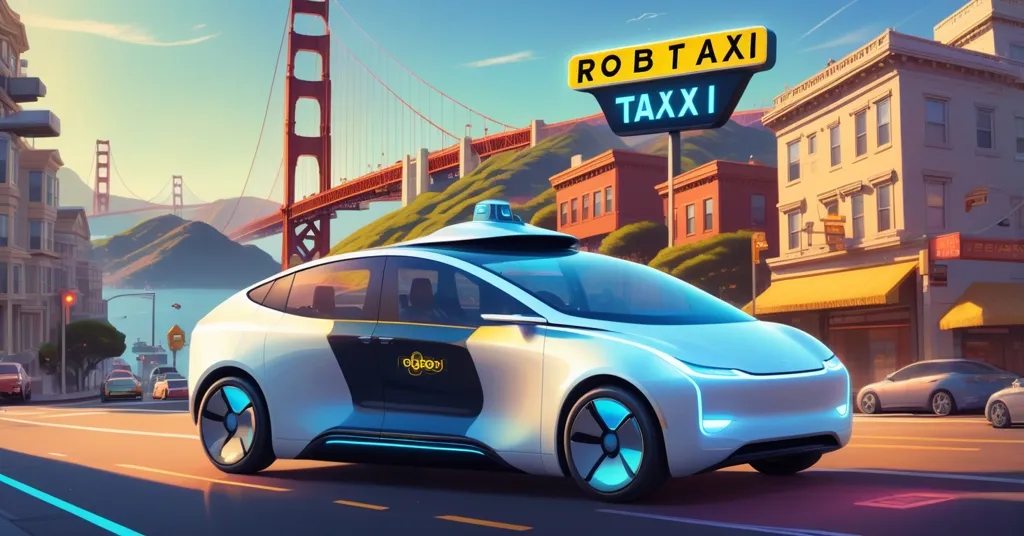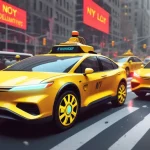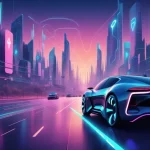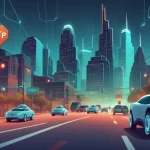Tesla’s Robotaxi Launch in San Francisco: Human Drivers and Regulatory Roadblocks Delay Autonomy

Tesla’s Robotaxi Rollout in San Francisco: Big Promises, Human Drivers, and a Long Road Ahead
Tesla is kicking off a limited robotaxi service in San Francisco this weekend, but before you picture driverless cars gliding through the Bay Area, brace for reality: these are human-driven rides with a Tesla badge, a far cry from the autonomous future Elon Musk has hyped for years. With regulatory walls, legal battles, and financial strains piling up, this launch feels more like a cautious test drive than a revolutionary leap—yet it still sparks curiosity about decentralized transport, a concept that resonates deeply with our Bitcoin and blockchain ethos.
- Human-Driven Launch: Tesla’s San Francisco robotaxi service starts with safety drivers due to missing permits for full autonomy in California.
- Regulatory Barriers: Strict state rules and legal threats over self-driving claims stall Tesla’s driverless ambitions.
- Broader Challenges: Financial downturns and delays in projects like Optimus robots highlight Tesla’s uphill battle.
San Francisco Rollout: Not Driverless, Not Yet
Tesla’s latest move in the San Francisco Bay Area is less a robotaxi breakthrough and more a chauffeur experiment. Launching this weekend, the service targets a select group—think friends and family of Tesla employees, plus a few public testers, likely Model Y owners invited to ride along. But don’t expect autonomy. As reported by Reuters, these aren’t self-driving vehicles navigating the hilly streets; they’re traditional rides with human drivers at the wheel, as detailed in updates about Tesla’s initial robotaxi operations in San Francisco. Why? Tesla lacks the necessary approvals from the California Department of Motor Vehicles (DMV) for driverless operation and hasn’t clarified its standing with the California Public Utilities Commission (CPUC), the body overseeing commercial passenger transport like ride-hailing. For now, this setup is restricted, probably non-commercial, and limited to internal use or free rides, ensuring no laws are broken.
This follows a similar trial in Austin, Texas, launched on June 22, where about a dozen Model Y SUVs operate with human safety monitors riding shotgun. In San Francisco, Tesla’s Full Self-Driving (FSD) Supervised feature—a driver-assistance system requiring constant human oversight—might be active, but it’s nowhere near the hands-off autonomy Musk envisions. Ashok Elluswamy, Tesla’s self-driving lead, summed it up as keeping “the person in the driver’s seat, just to expedite, while we wait for regulatory approval.” It’s a pragmatic workaround, not a tech triumph. Think of it as a Tesla-flavored Uber, testing the waters while gathering real-world data from loyal customers, amidst ongoing challenges in the San Francisco rollout.
California’s Regulatory Wall: A Bitcoin-Level Challenge
Navigating California’s rules for autonomous vehicles is like mining Bitcoin in the early days—brutal, slow, and requiring proof of reliability at every step. Tesla’s stuck because it hasn’t secured DMV authorization for fully driverless rides, nor is there clear evidence of a CPUC permit to carry paying passengers. Both agencies have confirmed Tesla’s current permits only allow testing with safety drivers, not public autonomous transport, as highlighted in discussions about Tesla’s regulatory hurdles in California. Elon Musk’s insistence that they’re “working to secure the necessary approvals in California” sounds hopeful, but the state’s track record tells a different story.
“We are working to secure the necessary approvals in California.” – Elon Musk
Competitors like Waymo set the bar high, taking nine years and logging millions of testing miles before charging for rides in 2023. Tesla’s nowhere close, and California’s skepticism isn’t just bureaucratic—it’s fueled by safety concerns. The DMV is pushing to ban Tesla from selling cars in the state, accusing the company of misleading consumers with marketing around Autopilot and FSD, systems that imply autonomy but still demand human control, a point underscored in recent coverage of Tesla’s Autopilot legal battles. Christopher Beatty, a supervising deputy attorney general for California, has been blunt, claiming Tesla’s hyped-up language has deceived drivers for years. Add ongoing lawsuits over fatal crashes tied to Autopilot, and you’ve got a regulatory chokehold tighter than an SEC clampdown on unregistered tokens. Tesla’s also eyeing expansion in Arizona and Florida, where certifications for manned and unmanned testing are underway, but even there, safety scrutiny won’t vanish overnight.
Tesla’s Wider Woes: Robots, Revenue, and Reality
Beyond robotaxis, Tesla’s futuristic projects are hitting speed bumps. Take the Optimus humanoid robot, pitched as a game-changer with a target of 5,000 units by 2025. Current tally? Just a few hundred, with the next version, Optimus 3, not entering production until 2026, according to reports on Tesla’s Optimus production delays. Musk, ever the optimist, claims they’ll “scale Optimus production as fast as possible” and reach a million units annually within five years. But with Tesla’s Q2 revenue down 12%—dropping to $21.3 billion from $24.9 billion last year, per earnings reports—due to slumping electric vehicle sales, shrinking regulatory credit income (payments from selling environmental credits to other automakers), and weak energy storage performance, the cash for such moonshots might be tighter than expected.
“We will scale Optimus production as fast as possible and try to get to a million units a year as quickly as possible. We think we can get there in less than five years.” – Elon Musk
Then there’s Musk’s history of overpromises. A million robotaxis by 2020? Didn’t happen. A cross-country autonomous drive from LA to New York by 2019? Nope. These aren’t just missed deadlines; they’re a pattern that breeds skepticism thicker than San Francisco fog. It’s not unlike the 2017 ICO craze—bold whitepapers promising the world, but delivery often falls short. Tesla’s financial hiccups and production delays could further stall projects like robotaxis, much like bear markets throttle blockchain R&D. Innovation isn’t cheap, and reality bites hard, especially when considering the broader context of Tesla’s robotaxi technology ambitions.
Lessons for Crypto Disruptors: Decentralization Dreams Meet Roadblocks
For us in the crypto space, Tesla’s robotaxi saga hits close to home. The vision of a decentralized transport network—where autonomous fleets disrupt centralized giants like Uber—mirrors how Bitcoin and blockchain challenge traditional finance. Imagine peer-to-peer rides settled via Bitcoin’s Lightning Network for instant, low-fee payments, or smart contracts on Ethereum handling fare agreements without middlemen. It’s the kind of effective accelerationism (e/acc) we champion: pushing tech forward, prioritizing freedom, and smashing legacy systems. Tesla’s push, even if stumbling, could spark that kind of momentum, just as Bitcoin did post-2009—slow, messy, but potentially transformative, a topic explored in community discussions on Tesla’s human-driven robotaxi launch.
Yet, the parallels don’t stop at ambition. Tesla’s regulatory battles echo the SEC’s crackdowns on altcoins or the CFTC’s grip on DeFi. Innovation outruns policy, and the backlash is inevitable. Fatal Autopilot crashes aren’t unlike crypto rug pulls—both erode trust when tech overpromises and under-delivers. Tesla’s marketing hype, much like shameless price predictions in crypto, risks alienating users if safety or reliability lags. And just as Bitcoin maximalists warn against centralized control, Musk’s singular influence over Tesla raises red flags compared to Bitcoin’s leaderless ethos. Still, there’s value in experimentation, akin to altcoins finding niches Bitcoin doesn’t serve. Tesla’s robotaxi vision might not be the endgame, but it’s a necessary testbed for disrupting transport, provided they don’t crash and burn on empty promises, as debated in forums like regulatory challenges for Tesla’s robotaxi service.
Where Does This Leave Tesla’s Vision?
Tesla’s San Francisco rollout is a baby step dressed in robotaxi hype. It’s human-driven, bogged down by California’s ironclad regulations, legal threats over misleading self-driving claims, and lawsuits tied to tragic Autopilot failures. Financial strains and delays in side projects like Optimus remind us that even the boldest disruptors face harsh realities. We’re all for the vision—decentralized transport aligns with our love for freedom and innovation—but let’s not swallow the hype whole. Tesla needs to prove it can crawl before it sprints, or in this case, drive itself. Picture a future where robotaxis run on a blockchain, cutting out middlemen with pure P2P rides. Is Tesla the one to build it, or just another overblown promise in a long list of misses? Time, not tweets, will tell.
Key Takeaways and Questions
- What’s Behind Tesla’s San Francisco Robotaxi Launch?
It’s a limited, human-driven chauffeur service for a select group, not autonomous, due to missing permits for driverless operation in California. - Why Are Tesla Robotaxis Stuck with Human Drivers?
California’s DMV and CPUC haven’t approved driverless rides or commercial passenger transport, forcing Tesla to rely on human oversight. - How Do Legal Issues Threaten Tesla’s Self-Driving Goals?
The DMV seeks to ban Tesla sales over misleading Autopilot and FSD claims, while fatal crash lawsuits spotlight safety flaws. - Should We Buy Into Elon Musk’s Robotaxi and Optimus Timelines?
Past flops, like a million robotaxis by 2020, suggest caution—Musk’s optimism often outstrips reality, much like hollow crypto promises. - What Can Crypto Fans Learn from Tesla’s Decentralized Transport Push?
Tesla’s vision of disrupting centralized ride-hailing parallels blockchain’s fight against traditional finance, but both grapple with regulatory pushback and trust gaps from overblown claims.



